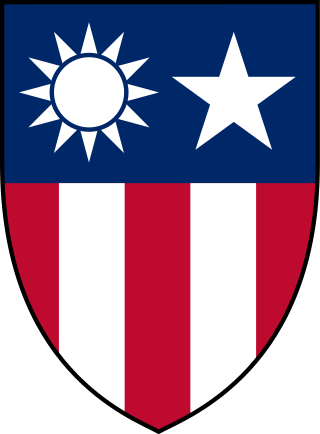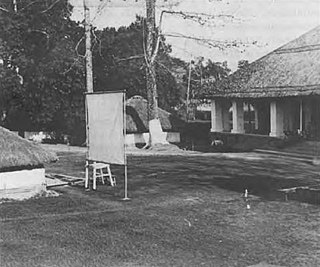
The Office of Strategic Services (OSS) was an intelligence agency of the United States during World War II. The OSS was formed as an agency of the Joint Chiefs of Staff (JCS) to coordinate espionage activities behind enemy lines for all branches of the United States Armed Forces. Other OSS functions included the use of propaganda, subversion, and post-war planning.

The United States Army Special Forces (SF), colloquially known as the "Green Berets" due to their distinctive service headgear, is the special operations branch of the United States Army. Although technically an Army branch, the Special Forces operates similarly to a functional area (FA), in that individuals may not join its ranks until having served in another Army branch.

The United States Army Special Operations Command (Airborne) (USASOC ( YOO-sə-sok)) is the command charged with overseeing the various special operations forces of the United States Army. Headquartered at Fort Liberty, North Carolina, it is the largest component of the United States Special Operations Command. It is an Army Service Component Command. Its mission is to organize, train, educate, man, equip, fund, administer, mobilize, deploy and sustain Army special operations forces to successfully conduct worldwide special operations.

The United States Naval Special Warfare Command (USNSWC), also known as NAVSPECWARCOM and WARCOM, is the naval component of United States Special Operations Command, the unified command that oversees and conducts the nation's special operations and missions.

China Burma India Theater (CBI) was the United States military designation during World War II for the China and Southeast Asian or India–Burma (IBT) theaters. Operational command of Allied forces in the CBI was officially the responsibility of the Supreme Commanders for South East Asia or China. In practice, U.S. forces were usually overseen by General Joseph Stilwell, the Deputy Allied Commander in China; the term "CBI" was significant in logistical, material and personnel matters; it was and is commonly used within the US for these theaters.

Jungle warfare or woodland warfare is warfare in forests, jungles, or similar environments. The term encompasses military operations affected by the terrain, climate, vegetation, and wildlife of densely-wooded areas, as well as the strategies and tactics used by military forces in these situations and environments.

Detachment 101 of the Office of Strategic Services operated in the China-Burma-India Theater of World War II. On 17 January 1956, it was awarded a Presidential Distinguished Unit Citation by President Dwight Eisenhower, who wrote: "The courage and fighting spirit displayed by its officers and men in offensive action against overwhelming enemy strength reflect the highest tradition of the armed forces of the United States."

Psychological operations (PSYOP) are operations to convey selected information and indicators to audiences to influence their motives and objective reasoning, and ultimately the behavior of governments, organizations, groups, and large foreign powers.
National governments deal in both intelligence and military special operations functions that either should be completely secret, or simply cannot be linked to the sponsor. It is a continuing and unsolved question for governments whether clandestine intelligence collection and covert action should be under the same agency. The arguments for doing so include having centralized functions for monitoring covert action and clandestine HUMINT and making sure they do not conflict, as well as avoiding duplication in common services such as cover identity support, counterespionage, and secret communications. The arguments against doing so suggest that the management of the two activities takes a quite different mindset and skills, in part because clandestine collection almost always is on a slower timeline than covert action.

The US employs divers in several branches of the armed forces, including the navy, army, marines, air force and coast guard.

The Secret Intelligence Branch of the United States' Office of Strategic Services was a wartime foreign intelligence service responsible for the collection of human intelligence from a network of field stations in Asia, Europe, and the Middle East.

The Deployable Specialized Forces (DSF) —formerly Deployable Operations Group— are part of the United States Coast Guard that provide highly equipped, trained and organized deployable specialized forces, to the Coast Guard, United States Department of Homeland Security (DHS), United States Department of Defense (DoD) and inter-agency operational and tactical commanders. The command was formerly headquartered in Arlington, Virginia where it was established on 20 July 2007, and was commanded by a captain. It was decommissioned by the Commandant of the Coast Guard, Admiral Robert Papp on 1 October 2013, with units previously assigned to the DOG being split between Coast Guard Pacific and Atlantic Area commands. The units were subsequently reorganized under Deployable Specialized Forces (DSF).

Morale Operations was a branch of the Office of Strategic Services during World War II. It utilized psychological warfare, particularly propaganda, to produce specific psychological reactions in both the general population and military forces of the Axis powers in support of larger Allied political and military objectives.
The head of the Office of Strategic Services (OSS), William Donovan, created the X-2 Counter Espionage Branch in 1943 to provide liaison with and assist the British in its exploitation of the Ultra program's intelligence during World War II. A few months before, Donovan had established a Counterintelligence Division within the Secret Intelligence Branch of the OSS but rescinded this order upon development of the X-2. The X-2 was led by James Murphy, whose branch would have the power to veto operations of the Special Operations and Secret Intelligence Branches without explanation. Donovan modeled the Counter Espionage Branch on British Counter Espionage. With the creation of the X-2 Branch, the British insisted that it follow British security procedures to maintain the secrecy of Ultra. The X-2 established separate lines of communication for itself as a self-contained unit. By the end of World War II, the X-2 had discovered around 3,000 Axis agents.

The Research and Analysis Branch(R&A) was a branch of the Office of Strategic Services. (OSS) Established in the OCOI with the appointment of James Phinney Baxter III as the first Director of Research and Analysis, July 31, 1941, the branch became operational within the Office of the Coordinator of Information on August 27, 1941. With OSS General Order 1 on October 17, 1942, R&A was absorbed into the new structure of the OSS. On January 4, 1943, with the restructuring of the OSS in OSS General Order 9, R&A was placed under the leadership of the Deputy Director of the Intelligence Service.

The Maritime Unit (MU) was a branch of the Office of Strategic Services that enabled maritime warfare for the allies during World War II. MU's mission was to "infiltrate agents and supply resistance groups by sea, conduct maritime sabotage, and to develop specialized maritime surface and subsurface equipment and devices." MU developed specialized boats, equipment, and explosives, fashioned underwater breathing gear, waterproof watches and compasses, an inflatable motorized surfboard, and "a two-man kayak that proved so promising that 275 were ordered by the British."

The Special Operations Branch (SO) was a branch of the Office of Strategic Services during World War II that "pioneered" many of the unconventional warfare, counter-insurgency (COIN), and foreign internal defense tactics and techniques used by today's US Military Special Operations Forces (SOF). Special Operations was the American equivalent of the Special Operations Executive (SOE) of the United Kingdom.

Millard Preston Goodfellow, who often went by the name "Preston Goodfellow," was an American soldier, spy, diplomat, journalist, war correspondent, and newspaper publisher. A veteran of World War I, Goodfellow became a leading figure at the Office of the Coordinator of Information and the Office of Strategic Services during World War II.

Robert A. Solberg (Solborg) was a soldier and spy during World War I and World War II, becoming a key figure in the development of the Office of the Coordinator of Information and the Office of Strategic Services, precursor to the Central Intelligence Agency.

Garland H. Williams (1903–1993) was an American pioneer of covert investigations, military counterintelligence, white collar investigations, espionage, training and planning, and a lifelong law enforcement officer. He is a veteran of World War II and the Korean War. During World War II, Williams was integral in the training of thousands of American hopeful would-be undercover operatives and guerrilla fighters in both the Military Intelligence Division and the Office of Strategic Services.















